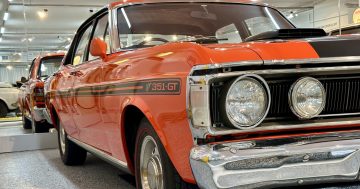
Holden Prototype Car No. 1. Photo: National Museum of Australia, Facebook.
It was a very sad goodbye when Colin McPherson moved into a retirement home a few years ago. The 1952 Holden 48/215 (or ‘FX’) he’d rescued from a deceased estate sale some 20 years earlier had to go.
“I loved that vehicle – I still very much regret it going,” he says.
He’s far from alone in his love for the car that put Australia on the road, and he’ll be joined by other members of the local FX/FJ Club of Canberra at the National Museum of Australia’s Mitchell storehouse this Sunday (25 February) to mark its 75th birthday.
The first customer took delivery of a Holden on 24 February, 1949; a man by the name of Essington Lewis, managing director of the BHP mining company and wartime director of munitions.
Steel was hard to come by in the post-war years, to the point many Canberra houses built around that time feature concrete sinks, but Lewis played a major role in making sure Holden had what it needed.
The very same car is now stored in the museum’s collection, along with ‘Prototype 1’, the first of three prototypes hand-built in Detroit by General Motors and subsequently shipped to Australia ‘for appraisal’; an FJ Holden formerly loved by Molly Goodall, who drove it regularly between her Tharwa sheep farm and Queanbeyan; and the last Holden Calais to come off the production line on 13 October 2017.

The museum’s 1946 Prototype No 1 Holden sedan. Photo: Lannon Harley.
As for Colin’s Holden FX – ‘Lebanon Green’ with a red leather interior – it was almost a local ‘barn find’.
The previous owner was a “great fisherman”, and while out on one of his fishing trips near Uriarra Crossing, died of a heart attack moments after wrestling a “bloody great big cod” out of the river.
Heartbroken, his wife effectively turned the Holden into a shrine by locking it away in the shed and forbidding anyone from entering. It sat there, gathering dust, for 27 years before the wife had to move into care and Colin’s sister, a friend of the family, alerted him to the car.
Colin made an offer, including his intention to “try and keep it in as near original condition as possible”, and the family accepted it.

The museum’s 1955 FJ Holden Special sedan, formerly owned by Molly Goodall. Photo: Dragi Markovic.
“It was very dusty and dirty, but after I cleaned it up, it was quite incredible. It still had the original red leather seats in excellent condition, and the paintwork was all very good. I did the brakes in it, cleaned out the cooling system, and fixed a fuel problem.”
All up, it was on the road again within a year.
“I pushed a pen around a desk all my life, so to get down in the garage and get my hands dirty – that was rewarding.”
Colin grew up on Canberra Avenue in the days when the site opposite the Russian Embassy was occupied by Commonwealth Motors, and remembers joining the crowds of people that would rush through the dealership’s doors whenever a new Holden model rolled in.
“The sale room would be flooded by people coming up to have a look – it was quite amazing the number it would attract.”
In the 1940s and ’50s, travelling around Australia by car was tedious and awkward. Tarmac was largely limited to the main roads of towns and cities and ran out a few kilometres into the country. Bridges were few and far between, to the point the pilgrimage to the South Coast involved getting a ferry across the Clyde River at Nelligen and then again at Batemans Bay.
“This is what the Holden grew up on,” Colin says.
“Everyone used to argue it was a flimsy car, and that’s because it didn’t have a chassis. It was a monocoque construction. And I remember nearly everyone who had a Holden also had a bag of cement in the boot to better hold it down to the road.”

Inside the prototype Holden. Photo: National Museum of Australia.
The popularity of the Holden forced the governments and councils of the day to take cars seriously, and more investment in roads followed.
“It was so successful because, following the war, all the men who came back had been trained on technical, mechanical things, so everyone was screaming out for a vehicle in Australia. It was just the right time, if I can put it that way.”
Colin reluctantly sold his FX to a guy in Brisbane, who was pleased with its original condition.
“It depends very much on the condition … but a good FX could go for $50,000 to $60,000 quite easily.”
Sunday’s Holden display is only open to invited guests, but the National Museum of Australia is open every day from 9 am to 5 pm.





















